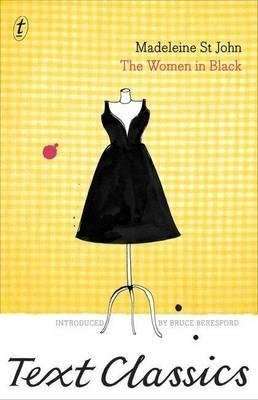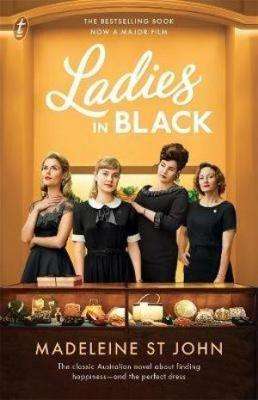The Women in Black by Madeleine St John, Review: Wit & charm
Madeleine St John’s The Women in Black is the much-loved classic novel that inspired the movie Ladies in Black.
The Women in Black Synopsis

Written by a superb novelist of contemporary manners, The Women in Black is a fairytale which illuminates the extraordinariness of ordinary lives.
The women in black are run off their feet, what with the Christmas rush and the summer sales that follow. But it’s Sydney in the 1950s, and there’s still just enough time left on a hot and frantic day to dream and scheme… By the time the last marked-down frock has been sold, most of the staff of the Ladies’ Cocktail section at F. G. Goode’s have been launched into slightly different careers.
With the lightest touch and the most tender of comic instincts, Madeleine St John conjures a vanished summer of innocence. The Women in Black, introduced by Bruce Beresford, is a great novel, a lost Australian classic.
“The book I most often give as a gift to cheer people up.” —Hilary Mantel
Genre: Chick Lit, Drama, Historical, Humour, Romance
Disclosure: If you click a link in this post we may earn a small commission to help offset our running costs.
Sign up to our Booklover Book Reviews emails and receive our gift for new subscribers. LEARN MORE >>
BOOK REVIEW
You cannot get a better recommendation for a novel than this endorsement for Madeleine St John’s The Women in Black from Hilary Mantel, “A pocket masterpiece. A jewel.”
I love a good British comedy of manners and The Women in Black is the first title I have read that I would describe as an Australian comedy of manners. The title is a reference to the uniforms the novels colourful lead characters, female sales assistants at a Sydney department store, were required to wear in the 1950s – shapeless and uncomfortable, designed to suit all body-types and hence being flattering to none.
Madeleine St John’s prose has a real no-nonsense quality about it, very few airs and graces, which of itself evokes the spirit of suburban Australia back in the 1950s. She does not fall into the trap of being clever with her prose just for the sake of it – she simply lets the story elements and powerful symbolism speak for itself.
For example, the character Lesley Miles (‘please call me Lisa’) could be considered a metaphor for Australia itself at that time – clever, resourceful, eager to grow up and make its mark, but at the same time a little awkward and unsure of its place in the world.
‘I had not imagined you to have such a tale to tell – you Australians are mysterious people, no one would guess that this is a place where people can also suffer. It is the constant sunshine, it hides everything but itself.’
More than a comedy of manners
The Women in Black by Madeleine St John is on one level a charming Australian comedy of manners, another a powerful reflection on 1950s Australian society.
Deeper themes explored within The Women in Black include classism in our supposedly classless society, the advancement of women and Australia’s tall poppy syndrome more broadly.
‘Fay’s just told me you’ve done very well in the examinations,’ said Miss Jacobs in a matter of fact tone. ‘Is that right? Well, that’s no surprise to me at all. I don’t expect it’s a surprise to you either. You’re a clever girl, I could see that. It’s a pleasure to work with you and I’ll be sorry when you leave us. You’ll be going to the university, won’t you, of course you will. A clever girl is the most wonderful thing in all Creation you know; you must never forget that. People expect men to be clever. They expect girls to be stupid or at least silly, which very few girls really are, but most girls oblige them be acting like it. So you just go away and be as clever as you can; put their noses out of joint for them. It’s the best thing you could possibly do, you and all the clever girls in this city and the world. Now, then. We’d better get on and sell some Cocktail Frocks, hadn’t we? Yes indeed.’
The influence post World War II migrants had in shaping the Australian way of life we know and love today is also featured.
‘Well, enjoy yourself while you can,’ he said. ‘And what’s this?’ He picked up a slice of salami.
‘That’s salami,’ said Mrs Miles. ‘I got it for Lesley.’
‘There’s no keeping up with you, Lesley,’ said her father. And, he thought, it’s true. She’s even beginning to look pretty. Filling out. Quite the young lady. Well, what a day it had been.
‘Salami, eh,’ said Mr Miles, tasting it. ‘I suppose I could get used to it. Let me try another piece. Quite tasty. What’s it made of?’
In this Text Classics reprint of The Women in Black, Bruce Beresford, literary executor for the late Madeleine St John, provides a candid introduction to the author and her life. Madeleine was just as interesting a character as those she created in her novels.
The Women in Black by Madeleine St John is a quick and entertaining read – a sharp social commentary delivered in a witty and charming package.
BOOK RATING: The Story 4.5 / 5 ; The Writing 4.5 / 5
Get your copy of The Women in Black (Ladies in Black) from:
Amazon Book Depository Booktopia
Related Reads:
Cloudstreet by Tim Winton / The Philosopher’s Daughters by Alison Booth / The War Widow by Tara Moss / I for Isobel by Amy Witting / Who We Were by Lucy Neave / A Fortunate Life by A B Facey
About the Author, Madeleine St John
Madeleine St John was born in Sydney in 1941. She studied Arts at Sydney University, where her contemporaries included Bruce Beresford, Germaine Greer, Clive James and Robert Hughes. She graduated from Sydney University in 1963 and lived in London for most of the succeeding years, until her death in 2006. In 1993, St John published her first novel, The Women in Black, the only book she set in Australia. She also wrote A Pure Clear Light (1996), The Essence of the Thing (1997), which was short-listed for the Booker Prize, and Stairway to Paradise (1999).
Movie Adaptation – Ladies in Black
Bruce Beresford (Introduction) is one of Australia’s best-known film and opera directors. In addition to the recent ‘Ladies in Black’ movie release, his films popular films include The Getting of Wisdom, Driving Miss Daisy and Breaker Morant.
* This novel counts towards my participation in both the Aussie Author Challenge 2013 and the Australian Women Writer’s Challenge.

